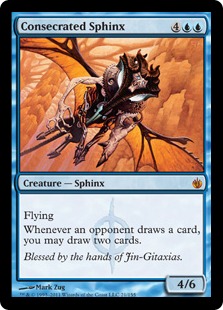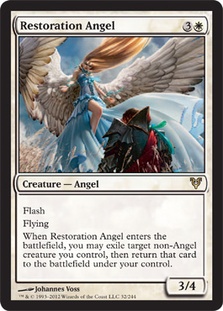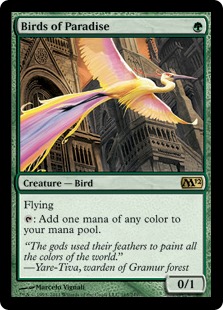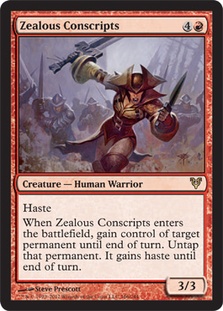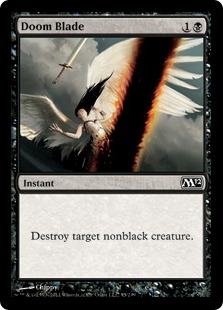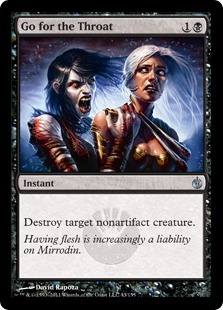Creating videos for this site has had an interesting impact on my preparation for Standard. Instead of spending my time learning to play the best deck or finding which deck I most want to play, I spend most of my time trying to think of new decks to build and then figuring out how to make each of them be the best deck they can be. This is distinctly different from figuring out how to make the best deck overall.
The best deck overall is Delver, but that’s not what I’m trying to build because people don’t want to watch endless Delver videos. Instead, I try to pick something moderately new and build my own version of it.
In doing this, I’ve found that it’s pretty easy to build competitive decks. It’s hard to build new decks that are amazing, but if you just want to win a few matches, it’s not very hard.
I’m going to try to tell you how to build new Standard decks that are competitive.
Of all the Magic Online Daily Events I’ve recorded for this site, I believe the only one I’ve won all of my matches in was one of the two in which I played the card Delver of Secrets. This is a slight coincidence, but it’s not random. I am very obviously handicapping myself by playing new decks rather than just grinding Delver, and it does have a spillover impact into real tournaments I play in.
I played U/W Midrange in St. Louis because I was more familiar with it than with Delver. The deck choice was reasonable because the advantage of doing something a little different than what other decks were doing actually outweighed the cost of playing a slightly weaker deck.
Let me explain. Delver is a better deck. Specifically, Delver of Secrets and Swords are better than planeswalkers and Consecrated Sphinx, which is the essential difference between my deck and Matt Costa deck from the SCG Standard Open in Worcester. However, when people didn’t know what I was doing and they could be expected to misevaluate my deck, play, and sideboard suboptimally against the cards I had, that advantage outweighed the value I was giving up. I knew I was building a deck for a single tournament, and I knew it would only work if I didn’t talk about it much beforehand.
As it turns out, the deck is only barely worse than Delver, which is still easily good enough to win events. It was able to win the next day against many of the same people who’d just seen me play it, and a lot of people have messaged me recently to tell me how well it’s been doing since. That’s cool, but I still don’t think I built the new best deck, and I don’t think it’s correct to play that build over Delver now that it’s known.
What that deck does is prove there’s room in the format to get enough value out of catching people off guard to justify not playing the best deck. That means that if you’re set on not playing Delver of Secrets for some reason, there’s a good chance you’ll be better served by building something new where you can at least have the advantage of surprise over playing a known deck that isn’t Delver. If you don’t have the advantage of surprise over Delver then I’m not sure exactly what your edge is—the other decks are so much worse that it’s hard to see how to exploit the metagame with them. As I mentioned in a previous article, Delver does everything better than everyone.
Anyway, enough prologue; on to the matter at hand.
What you need to understand about this format is that relative to other Standard formats it has better spells and worse mana. The mana is passable, but it’s the primary constraint on most deckbuilding. There have been times when you could play as many duals as you needed in almost any color combination, but this Standard format is not like that. It’s not Block either; you can make a lot of decks work, but the lands are weaker than the spells relative to other points in (relatively recent) history.
This is only a really serious issue for enemy color decks, and even then, it’s workable. Three-color decks can also have issues with a lot of lands coming into play tapped.
As for the spells, I think there’s a pretty clear hierarchy in power level of the colors at the moment:

The blue core of Snapcaster Mage, Ponder, Gitaxian Probe, Mana Leak, and Vapor Snag is absurd. It’s almost Legacy power level, and nothing else comes close to it. The easiest way to build a new deck is to play those cards and whatever support cards you feel like. This is an easy recipe to build a deck that’s cuter than Delver but also strictly worse, since it’s doing the same thing with either worse mana, worse synergy, or a worse curve. This is not to say that these decks aren’t worth building and can’t have advantages.
The best things to do in the format seem to be exploiting the above engine; playing a linear aggro deck of some sort like Humans, Infect, or something even more fringe like Goblins; maximizing the power of some planeswalker or planeswalkers; getting a big creature into play via ramp, Unburial Rites, or Birthing Pod; or taking advantage of Lingering Souls.
A deck like G/R Aggro doesn’t exactly fit into any of those, but I think I’m comfortable saying that’s not the best thing to do in this format.
Building linear aggro decks is pretty straightforward. Choose a mechanic like Infect or Human matters and devote your entire deck to winning with it as quickly as possible. Make sure you don’t lose to Gut Shot and Vapor Snag, and if possible, hedge against Day of Judgment while you’re at it.
I think the Blue/X Goodstuff decks are where there’s the most room to play whatever you want, so I want to look at what each color offers.
Blue
Blue has too much. In addition to the package I discussed earlier, it has Delver, Phantasmal Image, Consecrated Sphinx, Think Twice, and other counterspells. It also has a few good planeswalkers.
White
Restoration Angel is the best white card in Standard. Even if you’re not doing the trivial amount of work required to get a lot of value out of its enters the battlefield ability, it’s still a very well positioned creature. It’s the best reason to play white in most decks right now.
Blade Splicer’s stock moved up dramatically because of Restoration Angel. It’s the easiest way to get a lot of value out of the Angel on curve.
Thalia, Guardian of Thraben is one of the better cards in the format against Delver decks. The problem is that you have to make the rest of your deck pretty bad to be able to play her, and then you’re in rough shape in matchups where she isn’t good, or when you don’t draw her, or when they have the Gut Shot.
Day of Judgment is one of the best cards in the format against a variety of bad decks that people shouldn’t be playing, and it’s a passable role-player against most decks.
Gideon Jura is weirdly positioned right now. There are a lot of threats he’s not optimal against, like Geist of Saint Traft and Primeval Titan, but if you have some support he can take over a game.
Hero of Bladehold is an excellent bullet against ramp and most non-blue or black strategies.
The other primary incentive to white is its utility spells like Divine Offering, Revoke Existence, Timely Reinforcements, Celestial Purge, and Oblivion Ring.
Green
Birds of Paradise is the best green card, and how good it is is almost strictly a function of how many Gut Shots people have. Birds getting killed by Gut Shot is worse than Delver of Secrets suffering the same fate because in order for a deck to take advantage of the mana provided by Birds of Paradise, it has to increase its curve in such a way that it suffers substantially when it doesn’t have the Bird. That said, if all someone can do is Vapor Snag it they’re not getting the tempo they need out of that Vapor Snag most of the time, and they’re basically just down a card.
Primeval Titan is the green spell to ramp into.
Naturalize is a horrifically underplayed card right now; I see it as one of the primary draws of the color. The combination of being an instant and being able to hit enchantments makes it a much more powerful and better maindeck card than the alternatives in other colors, and it’s always performed amazingly for me.
Birthing Pod is one of the more powerful and unique things you can do in the format. The problem with it is that I think it’s too slow and life consuming to really shine against Delver, but there is hope for Birthing Pod particularly because it, like Thalia, generally asks you to build around creatures. I really like the plan to build a Birthing Pod deck that sides out Pods for Thalias against Delver.
Outside of that, green has a host of solid value creatures like Acidic Slime and the underplayed Stingerfling Spider as well as role-players like Rampant Growth, Crushing Vines, Beast Within, and Green Sun’s Zenith
Red
The most appealing red card to me (outside of Gut Shot) is Zealous Conscripts. This card just has such game breaking upside.
More realistically, red offers a wealth of ways to efficiently kill small creatures with upside. Pillar of Flame, Whipflare, Arc Trail, Bonfire of the Damned, even Devil’s play all fill similar roles.
Outside of burn, red offers Hellrider, Inferno Titan, and to a lesser extent Chandra’s Phoenix and Stromkirk Noble.
Ancient Grudge is the best at what it does (but I still slightly prefer Naturalize).
Kessig Wolf Run is probably the best red card, if you count it that way.
Huntmaster of the Fells is overplayed, but it’s not horrible in all decks. I think aggressive decks play it more than they should, but if all you’re looking to do is buy time to play spells that can actually win a game, it’s a solid role-player that can occasionally overperform.
Black
Doom Blade / Go for the Throat might be the best black cards right now. But they’re not that exciting.
The best reason to play black is for flashback on Lingering Souls and/or Forbidden Alchemy.
I want to say Darkslick Shores is the best black card, but that’s kind of cheating.
Grave Titan is pretty good but not amazing since so many of the creatures you’re trying to trump fly.
Liliana isn’t bad, but it requires a lot of black; Tezzeret’s powerful, but the decks built around him have to play a lot of cards you don’t really want to be playing.
Then there are some Zombies…
Things have been rough for black since planeswalkers were printed because it’s not great at removing them and they generally play well against black. The discard spells just aren’t quite what you want to be doing right now. Duress in M13 should help a lot. I think black should get more creature removal spells that kill planeswalkers—it doesn’t seem that weird to me for black magic to be able to kill a planeswalker, but this isn’t really the place to get into that.
Most of what you need to do right now to build a deck is to find any interaction you want to exploit and then fill in the deck with cards that let you beat the major threats in the format: Delver, Geist of Saint Traft, Swords, Angels, tokens, and Titans. As long as you have a way to interact with each of those plans and planeswalkers, I guess, you should be alright.
Also don’t get hung up on playing four copies of a card. Most of my decks are full of 2-3 of various things. There are cards you’re building around that you want to see all the time; most decks should have a few of those, but there’s a lot of power in the flexibility you get by having just a few of a lot of things.
I’d like to give some examples, but I think the best way to see that is just to follow my videos.
So for those of you who try to build your own decks, I’m sincerely interested: what do you feel like you struggle with most or most need to know, if you have any idea what that might be?
Thanks for reading,
Sam
@samuelhblack on Twitter


